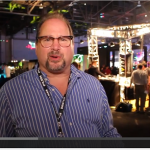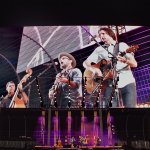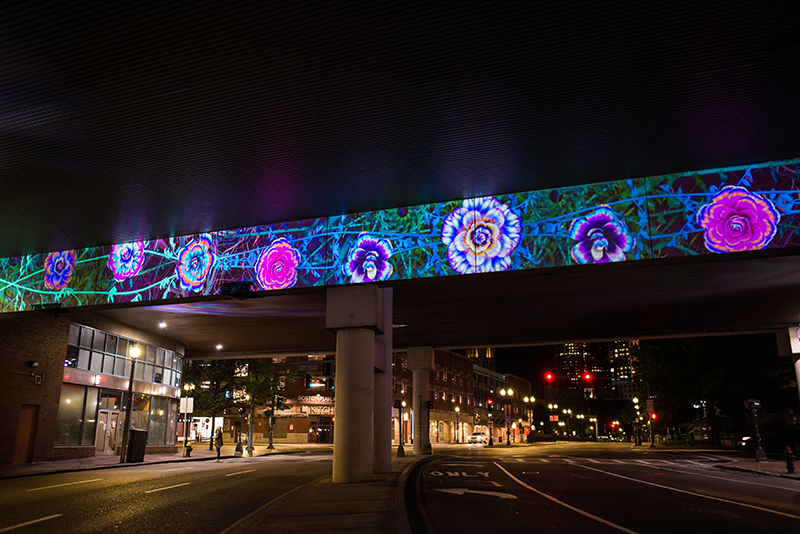
The Urban Underpass Project Launched with Zebbler’s City Bloom.
Studio HHH, the multidisciplinary design studio, specializing in large-scale art installations, interior architecture, and immersive environments, is currently running a very cool social-distancing installation called “Urban Underpass.” The project is a piece of public artwork located at Bulfinch Crossing in Boston. The first immersive outdoor projection installation in Boston, featuring initial visual artwork by Zebbler, is titled City Bloom and will be on display over the next few months, with potential for rotating artwork to take the project well into 2021.
Vanessa Till Hooper, founder and creative director of Studio HHH spearheaded the outdoor projection mapping project, which makes use of 24 Epson Pro L1755UNL and Pro L1715SNL 3LCD laser projectors with a variety of short-throw, zoom and wide angle lenses. “We were approached by a client group consisting of Bulfinch Crossing developers, National Real Estate Advisors and The HYM Investment Group, represented by the creative agency, Isenberg Projects,” she says.
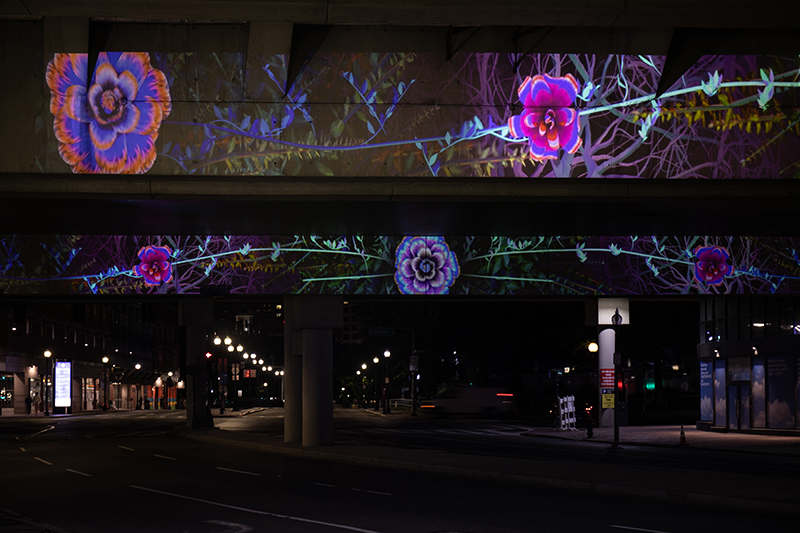
The “Urban Underpass” space is essentially a parking garage spanning a public street bridging two buildings. It proved an ideal canvas for bringing a beautiful experience for neighbors and visitors to the area. This positive art installation paved the way for the next phase of development. The client chose the work of Zebbler from a lineup of local artists that were considered as part of the selection process.
Originally inspired by a local flower store, the animation grew from a single projection to a building-wide video texture over the course of a few months. With verdant bursts of flowers, vines and branches slowly growing over the concrete underpass of the Government Center Garage, City Bloom is designed to bring an illuminated spark of joy to Boston, with its animation playfully exploring the boundary between a static fine art installation and a VJ performance.
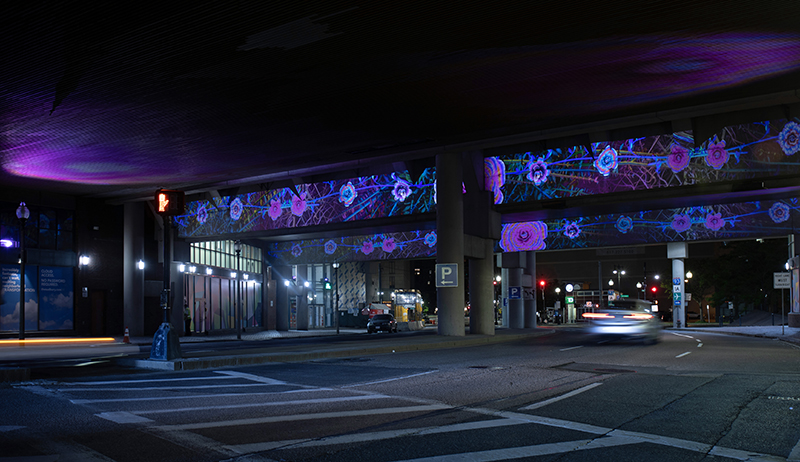
The idea for the project emerged in Dec. 2019. By early February, Zebbler was working fast and furiously to create his piece, which was ready to go when the Coronavirus pandemic shut everything down. “Our conversations with the client centered first on the fact that we wanted everybody to be safe, but that we thought this was still a beautiful opportunity to bring something to the public while in quarantine,” says Vanessa.
Adds Zebbler, “We started planning everything before the pandemic hit. I had formed in my head how this would look and what it would be. It has really been incredible that something I was able to create and share with people survived as we watched everything shut down,” he adds. “One of my biggest intentions was to provide people a chance of witnessing something beautiful without trying to be anything else. I just wanted to provide a spark of joy through something that could bring a little bit of happiness into this otherwise very stressful time.
“What is exciting about the installation,” says Vanessa, “is it can be a drive-through artwork, viewed by car, bike or by foot while social distancing. With museums and cultural institutions currently closed, we are so grateful to be able to bring a public artwork to the city of Boston that is safe for everyone to experience.”
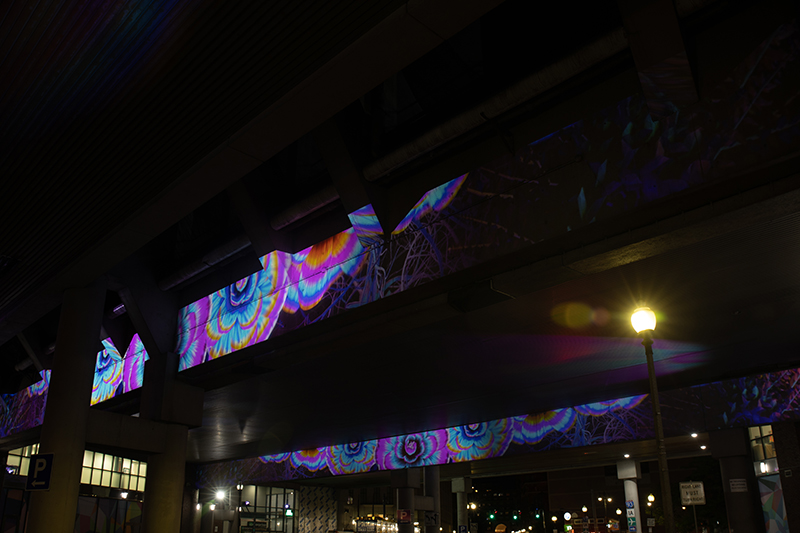
Zebbler, a talented projection mapping artist with multiple live festival event shows in his resume was grateful that “Vanessa and her team made everything so easy for me. They provided precise templates for the animation, so I had the confidence of knowing everything was correct down to the pixel.”
There were challenges, of course. “Certainly, the mapping,” says Vanessa, despite the fact she and lead projection mapping artist Pamela Hersch were able to work unencumbered in the vacant buildings and shallow traffic during the early days of reopening construction sites during the pandemic.
The first phase of the design process was determining where they could get access to the interior spaces, and how many projectors they could have at each location within the buildings, as well as determining what lenses would reach each area of the architectural “canvas” from each of those interior projector locations. Stitching that all together into an overall even effect from both sides took some time. “Synchronizing the mapping from two sides of the street was a logistical feat, one that I could not have accomplished without the careful planning by Pamela.”
In a perfect world, the architecture would have been symmetrical. Such was not the case. Two thirds of the projectors were on one side of the street, and the last third were on the opposite side of the street. Vanessa and her team were able to do a lot of pre-planning, however.
“We developed a 3D environment in which we mapped all of the location of the projectors and all of the content together within that 3D scene. Once we got onsite, it was very clear which projectors were angled in which direction. We had to lens them all specifically for the distance from possible location on the interior to canvas area on the exterior.”
Self-Timing Projectors
The Epson projectors have a lot of features that made that process easier, including self-timers so all the projectors turn themselves on at dusk and off at dawn each day. Studio HHH does not operate the installation remotely. Each projector has its own playback device and all projectors are connected via fiber over the span between buildings, and they are all synchronized together from both sides of the street. Studio HHH opted to eliminate a wireless system and computer controls so that the installation could be robust and self-sufficient and would not require remote supervision.
“That was new for us,” says Vanessa, “not running them from a computer remotely.” Epson projectors are able to start themselves up, turn themselves on and start streaming content automatically. Those features are what made this project possible for a long duration installation.
The client made an investment in the purchase of the Epson products following the guidance and expertise of Vanessa and her team. “The robustness of the Epson projectors is amazing. They have been continuously running without failure. Each projector only has that single segment of the entire video. It has a playback device that is only showing that little piece of the video. Each projector shows its own piece and it appears as continuous overall content.
“With the help of lead installer Bianca Maura of BRM Production Management, we worked with the city to ensure safety, including the fire department, transportation, and events bureau, as we were all going through a learning process together. They had never supported a long-term project like this in the city of Boston before, this was the first, so they had to think long and hard about it,” adds Vanessa.
A huge aspect of the visual impact of the installation is the speed of the animations — it had to be an acceptable rate of speed to the public eye traveling by vehicle or as a pedestrian. Vanessa, with the assistance of Zebbler, created an entire metric system to present to the city evaluating speed of animation. After everything was designed, ready to go and signed off by the powers that be, “we received a notice from the transportation department telling us nothing could be red, yellow, or green colors like streetlights — that was a curveball,” Vanessa notes. “Zebbler went back to the drawing board and reworked all the colors for the entire project and developed a completely new look which was even more beautiful and magical than the first iteration.”
“I focused on animating these quite lush beautiful floral textures that were continuously blossoming, unraveling, and changing,” says Zebbler. “Because we are in an area that is frequented by cars and people, we wanted to make it as un-distracting as possible. Everything is evolving slowly and patiently. I believe the final loop is close to 20 minutes. Vanessa’s team did all the dissecting of the video. All I had to do from my side of things, after understanding how the architecture of the space itself looked, was to seed the templates that were given to me with beautiful content.”
Adds Vanessa, “Seeing the project in person was even better than the design that was created. To finally go live with this project after so many months of anticipation, it was just breathtaking. It was incredibly rewarding to be given the opportunity to create something that the city had never seen before. The city was really working every angle on their side to make this happen, and the reward was something quite incredible and new for Boston.”
For more info, visit www.studiohhh.com, www.epson.com/high-lumen-projectors-for-large-venues, www.bulfinchcrossing.com, www.isenbergprojects.com, zebblerstudios.com and www.luminartz.org.
